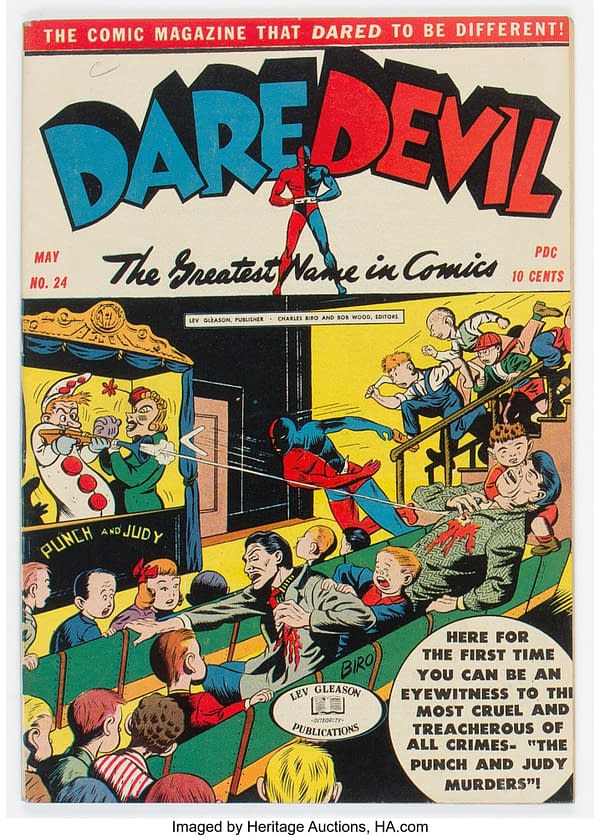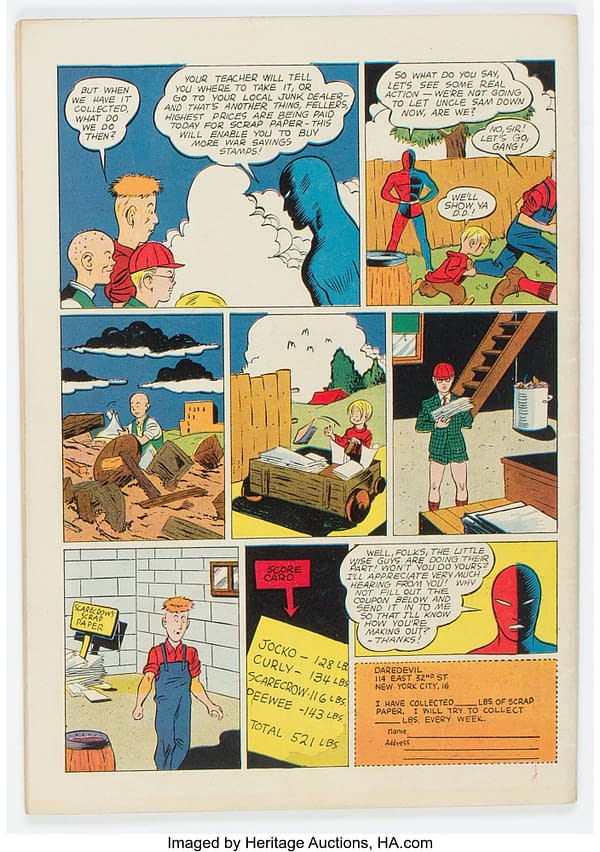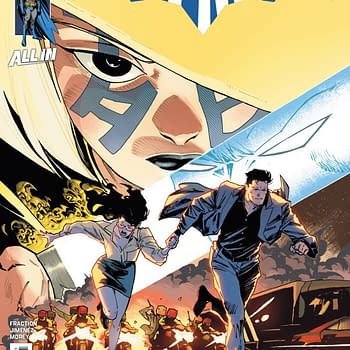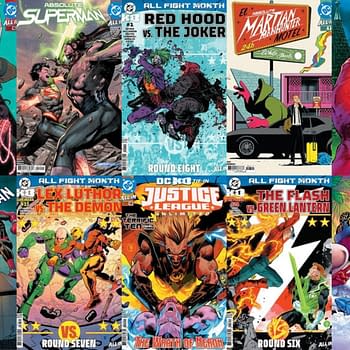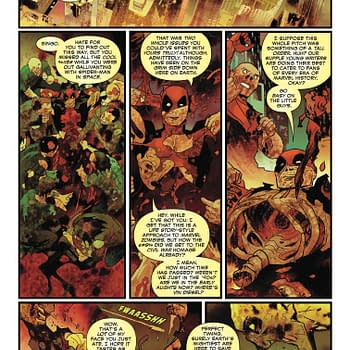Posted in: Comics, Heritage Sponsored, Vintage Paper | Tagged: Charles Biro, daredevil, lev gleason, Punch And Judy
When Punch And Judy Were Common In The US, Daredevil #24 at Auction
Lev Gleason's Daredevil #24 from 1944 features a rather lurid Punch and Judy cover by Charles Biro, with an interior story to match.
You don't see many Punch and Judy shows around the place these days. The star has faded somewhat, but when I was a kid, they were fairly common at fun fairs and were represented in popular culture. When Neil Gaiman and Dave McKean created their Mr Punch graphic novel in the nineties, it was to an adult audience familiar with the form. What I didn't know what that they were popular in the USA as well but faded after the 19th century. Britain kept it going till at least the end of the 20th.
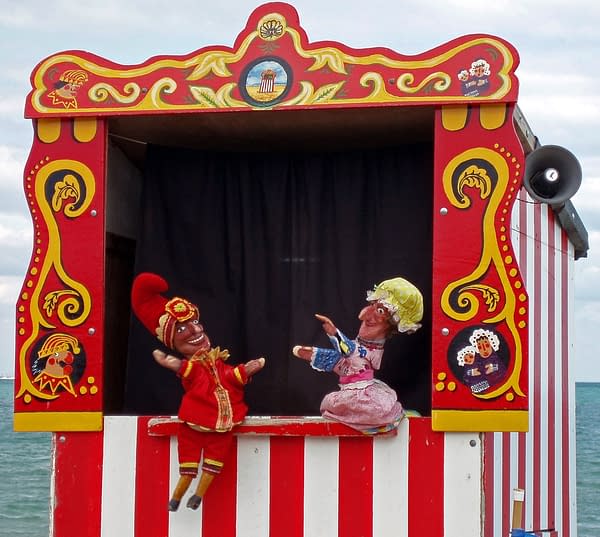
Originating in 16th-century Italian commedia dell'arte, Punch And Judy was a puppet show derived from the Neapolitan stock character of Pulcinella, a trickster character somewhere between Loki and Dennis The Menace (either variety). Originating in the street theatre Covent Garden in London in 1662 (where three hundred and thirty years later I would watch the young Eddie Izzard plying her trade). A Punch And Judy pub stands in the spot now, and t would mark a sea change in English culture, as King Charles II restored the English monarchy after the death of Lord Protectorate and republican puritan Oliver Cromwell. A King who, as Horrible Histories would put it, "liked to party". The theatres were back, and Punch And Judy took advantage of the new joie de vivre. Performed by Italian puppeteer Pietro Gimonde, it even got mentioned by Samuel Pepys in his famous diaries and gave rise to the expression "pleased as Punch".
Punch And Judy is a hand puppet show which plays out in a booth, the puppets held above the puppeteer's head, obscured by the tent in front. The show sees Punch, spoken using a special voice box that makes him squawk in a high-pitched vibrato, and the tale is told of mischievous Punch and his long-suffering wife Judy, who he beats senseless, and though she tries to give as good as she gets, she is murdered, to the delight of the audience. Punch is then arrested by the police (crocodiles, dogs and sausages are often involved) and Punsh is sentenced to death, though he managed to kill the hangman first before his own inevitable death, Notably Covent Garden was used to hang people, so it fitted the local vibe. Punch goes to hell where he continues his mischief with the Devil.

Punch moved beyond England in the nineteenth century and was very popular in Paris and British colonies such as Canada, Australia, India and the USA, where George Washinton attended shows. Back in Britain, it became a seaside attraction with red and white striped booths popular and familiar, intended a family entertainment, even though the content may be considered rather mature for some. Where Punch exists, that's where you may still find it, though it is much less common than it was only forty years ago.
But its popularity in the USA for a time may explain what on earth it is doing on the cover of Daredevil #24 published by Lev Gleason in 1944, Not the modern Marvel character but his predecessor, a copy of which is up for auction from Heritage Auctions right now. Created by Jack Binder, Bart Hill saw his father murdered while he himself was branded by a hot iron, in an attack. Orphaned, his boomerang-shaped scar inspired him to become a boomerang marksman and a vigilante fighting crime. More recently he was used by Erik Larsen in the Savage Dragon comics, retroactively establishing him as the first superhero of the Image Universe.
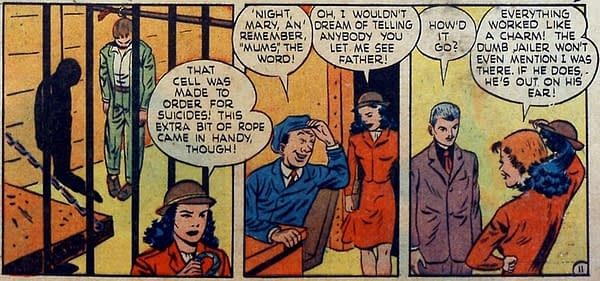
And here is the first, and only, Daredevil/Punch And Judy crossover, It is the only use of Punch and Judy in an American superhero comic book I can think of… in this comic Punch and Judy are a coupe and criminals who stage a fight in public only to attack, steal from and murder and do-gooders who try and help Judy. The audience is expected to be familiar with the knockabout Punch And Judy shows, including their propensity for hanging people.
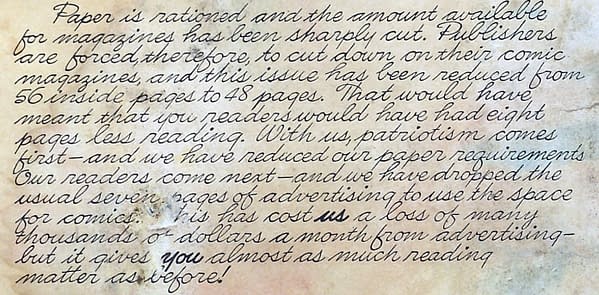
The story also includes cast members on a paper drive, trying to gather paper to be recycled and the introduction explains why the war effort and paper rationing has seen comic books drop page counts, but the publisher chooses to also drop advertising pages to give readers more story pages even with fewer overall pages. It was probably a stunt to save on printing costs as advertisers were dropping out due to the war economy, but it makes a damn fine excuse and one worthy of Mark Millar today. And the story itself contains other references to the wartime effort in the plot.
Daredevil Comics #24 (Lev Gleason, 1944) Condition: VF. Claw backup story. Contains a hanging panel. Charles Biro story, cover, and art. Dick Briefer and Norman Maurer art. Overstreet 2022 VF 8.0 value = $362.



